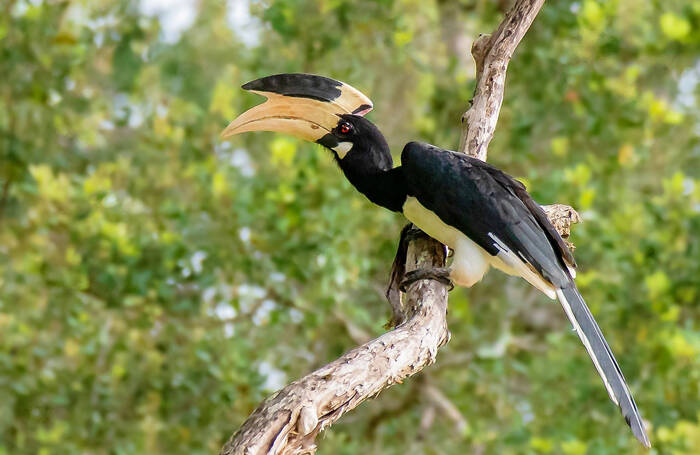Anthracoceros coronatus
IUCN
LCBasic Information
Scientific classification
- name:Anthracoceros coronatus
- Scientific Name:Anthracoceros coronatus,Malabar pied hornbill,Crowned Hornbill, Airplane Bird
- Outline:Climbing birds
- Family:R.hornbills R.bicolor
Vital signs
- length:74-77.6cm
- Weight:About 2kg
- lifetime:30-40years
Feature
The mouth has a large helmet process, which is waxy yellow or ivory white in color. There is a significant black spot in front of the helmet process.
Distribution and Habitat
The Pied Hornbill is distributed in China, India, Myanmar, Bangladesh, Sri Lanka, Thailand, Indochina and Malaysia.
In China, it is distributed in southwestern Yunnan, southern Xishuangbanna, and Fusui, Daxin, Chongzuo, Ningming, Longan, Longzhou, Jingxi and other places in Guangxi.
It mainly inhabits low mountains and evergreen broad-leaved forests at the foot of mountains below 1,500 meters above sea level.
Appearance
The head, neck, back, wings and tail of the male bird are black. The head, back and two wings have a metallic green luster, especially the two wings; the wing edges are white and mixed with black. Except for the first and second primary flight feathers and the inner secondary flight feathers, the tips of the flight feathers are all white. . The bases of the primary flight feathers are also white, forming conspicuous white wing spots on the wings. The outer tail feathers have broad white terminal spots. The chin, throat, upper chest and armpit feathers are black, and the rest of the underparts are white.
The female bird is similar to the male bird, but slightly smaller.
The black spot on the helmet process of male birds is much larger than that of female birds, from the base of the mouth to one-half or one-third of the tip of the helmet process, while the female bird has almost no black spots on the back of the helmet process.
The black spots on the helmet process of young bird
Details
The Malabar pied hornbill is called Malabar pied hornbill in English, and has 2 subspecies.

The Malabar pied hornbill is a resident bird. It often moves in groups except during the breeding season. It often lives and moves in trees, and sometimes forages on the ground. The call is "Gak, Gak, Gak", which is very loud. When flying, the head and neck are stretched forward, and the wings are spread out, which is very similar to an airplane, so it is commonly known as the "airplane bird".
The breeding season of the crowned hornbill is from April to June. It nests in caves, cracks or the bottom of tree holes on cliffs, and some nests can be used for several consecutive years. The height of the cave is about 60 meters from the ground, and the diameter of the cave entrance is about 60 centimeters. The nest is covered with pine leaves, weeds, feathers, etc. The diameter of the nest is 27 centimeters and the depth is 13 centimeters. Each nest lays 2 to 3 eggs, and the size of the eggs is 47 to 54 mm × 33 to 38 mm. The female bird incubates the eggs in the nest closed by the cave entrance.
Due to the peculiar breeding habits of the crowned hornbill, the Dai compatriots in the place of origin call it "love bird", and there is also a touching story circulating. It is said that a long time ago, there lived a young couple in the primeval forest. The man was called Yan Ge and the woman was called Yu Kan. Yan Ge was a good hunter of the Dai people, and Yu Kan was a famous beauty. They were newly married and affectionate. In order to prevent Yukan from being harmed by bad people when he went out hunting, Yan Ge would pull the stairs of the bamboo house upstairs every time he went out, and then seal the doors and windows from the outside, leaving enough food for Yukan, so that she could weave tube skirts and bamboo mats at home alone until he returned from hunting.
However, an accident happened once. Yan Ge got lost in the mountains while hunting, and returned home after more than 20 days, but Yukan had already starved to death. Yan Ge was heartbroken and cried loudly, then wrapped Yukan's body and himself with white cloth, and set the bamboo house on fire. From then on, this loving couple became two crowned hornbills, still maintaining their passionate and pure love and unique living habits.
The global population of Pied Hornbills has not been quantified, and it is a rare or common species in its native habitat. The male-female ratio of Pied Hornbills is seriously unbalanced, and the population continues to decline.
In March 2015, traces of Pied Hornbills were found in the White-headed Langur Reserve.
In June 2022, staff from the Chongzuo White-headed Langur National Nature Reserve in Guangxi monitored the breeding of Pied Hornbills, a national first-class protected animal, for the first time through photos while patrolling the reserve.
Listed in the "National Key Protected Wildlife List": National Second Class Protected Animal (effective December 10, 1988). (Note: Hornbill family, all species)
Listed in the "IUCN Red List of Endangered Species": Near Threatened Species (NT).
Listed in the "China National Key Protected Wildlife List" Level 1.
Protect wildlife and eliminate game.
Maintaining ecological balance is everyone's responsibility!








